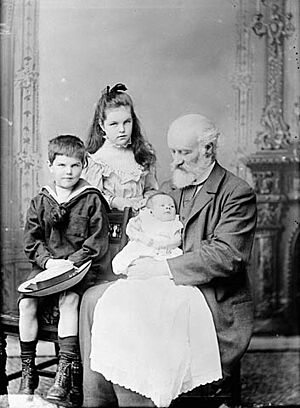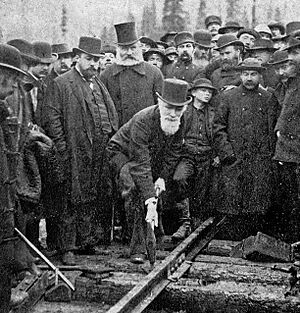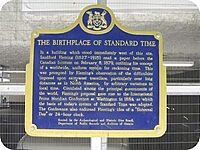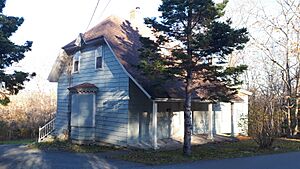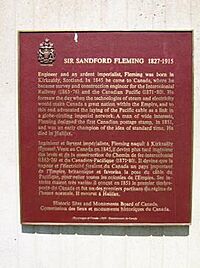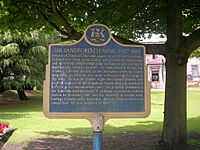Sandford Fleming facts for kids
Quick facts for kids
Sir
Sandford Fleming
|
|
|---|---|
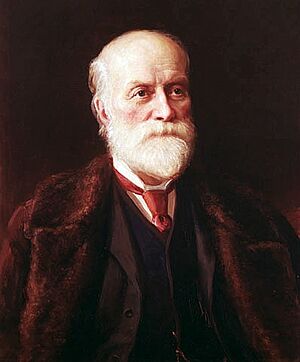
Portrait of Sir Sandford Fleming by John Wycliffe Lowes Forster
|
|
| Born | January 7, 1827 Kirkcaldy, Scotland
|
| Died | July 22, 1915 (aged 88) Halifax, Nova Scotia, Canada
|
| Occupation | engineer and inventor |
| Military Service | |
| Allegiance | Canada |
| Service/ |
Canadian Militia |
| Years of service | 1862–1865 |
| Rank | Captain |
| Unit | 10th Volunteer Battalion of Rifles |
| Known for | Inventing, most notably standard time |
Sir Sandford Fleming (born January 7, 1827 – died July 22, 1915) was a clever engineer and inventor from Scotland who moved to Canada. He is famous for many things, especially for suggesting standard time zones for the whole world. This idea helped create Coordinated Universal Time, which we use today.
Fleming also designed Canada's first postage stamp. He was a skilled land surveyor and map maker. He helped build important railways like the Intercolonial Railway and the Canadian Pacific Railway. He also helped start important groups like the Royal Society of Canada and the Canadian Institute, which is a science organization.
Contents
Early Life and Big Ideas
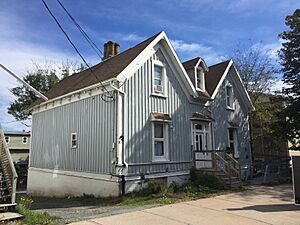
Sandford Fleming was born in 1827 in Scotland. When he was 14, he started learning to be a surveyor. In 1845, at age 18, he moved to Canada with his older brother. They traveled through cities like Quebec City and Montreal before settling in Peterborough, Ontario. He became a qualified surveyor in Canada in 1849.
In 1849, Fleming and some friends started the Royal Canadian Institute. It was first for surveyors, but it grew into a general science group. In 1851, he designed the "Threepenny Beaver." This was the very first Canadian postage stamp. He worked as a surveyor for the Grand Trunk Railway. Later, he became the Chief Engineer for the Northern Railway of Canada. He believed in building strong iron bridges instead of wooden ones for safety.
Fleming also served as a captain in the Canadian military from 1862 to 1865.
Family Life
When Fleming arrived in Peterborough, he met Ann Jane (Jeanie) Hall. They fell in love and married in January 1855. They had nine children together. Fleming was a loving family man. He even welcomed his father, stepmother, and six other siblings to Canada.
After his wife Jeanie passed away in 1888, his niece, Elsie Smith, helped him manage his home in Ottawa, Ontario.
Building Railways Across Canada
Fleming was a very important railway engineer. In 1863, he became the chief government surveyor for a railway line in Nova Scotia. He made sure the work was done well and saved the government money.
In 1862, he suggested a plan for a railway that would connect Canada from the Atlantic to the Pacific Ocean. The first part, from Halifax to Quebec, was very important. It helped New Brunswick and Nova Scotia join the Canadian Federation. This was because travel through the United States was difficult during the American Civil War.
In 1867, he became the chief engineer for the Intercolonial Railway. He worked on this project until 1876. He insisted on using iron and stone for bridges. People thought this was too expensive, but it proved to be safer from fires.
By 1871, a railway connection was needed to bring British Columbia into Canada. Fleming was asked to be the chief engineer for the Canadian Pacific Railway. In 1872, he led a small group to survey the route. They found a good path through the Rocky Mountains using the Yellowhead Pass. Even though he was later removed from his chief engineer role, he became a director of the Canadian Pacific Railway in 1884. He was there when the last spike was driven, completing the railway.
Inventing Standard Time Zones
Fleming is famous for starting the idea of standard time zones. One time, he missed a train in Ireland because the schedule was confusing. This made him think about how to make timekeeping easier for everyone.
In 1876, he suggested a single 24-hour clock for the whole world. He called this "Cosmopolitan time" or "Cosmic Time." He proposed 24 time zones, each one hour wide. These zones would be linked to the Greenwich Meridian. This meant that clocks within each zone would show the same time.
Fleming kept working on his idea. In 1879, he suggested that the prime meridian should be at Greenwich. The British Government shared his ideas with other countries.
He promoted his system at big international meetings. At the International Meridian Conference in 1884, they accepted the Greenwich Meridian. They also agreed on a universal day that starts at midnight in Greenwich. By 1929, most major countries used time zones. Today, we use UTC offsets and military time zones which are similar to Fleming's ideas.
Fleming also supported changing the calendar. He worked with Moses B. Cotsworth to promote a 13-month calendar. He was the president of the International Fixed Almanak Reform League until he died.
Later Life and Legacy
After leaving his railway job, Fleming became the Chancellor of Queen's University in Kingston, Ontario. He held this position for 35 years. He also strongly pushed for a submarine telegraph cable to connect all parts of the British Empire. This "All Red Line" was finished in 1902.
Fleming was a man of many ideas. He wrote a book about land policy. He also helped start several businesses. He was involved in the Ottawa Horticultural Society and the Rideau Curling Club. In the 1890s, he became interested in how elections worked and wrote books about it.
His achievements were recognized worldwide. In 1897, Queen Victoria made him a knight. He was also a freemason.
In 1883, he helped start the first "Alpine Club of Canada." Later, when the modern Alpine Club of Canada was founded in 1906, Sir Sandford Fleming became its first Patron and Honorary President.
In his later years, he lived in Ottawa and Halifax. He owned a summer home called "The Dingle" in Halifax. He later gave this land to the city, and it is now Sir Sandford Fleming Park. Fleming passed away at his Dingle summer cottage on July 22, 1915. He is buried in Ottawa.
Recognizing His Contributions
Fleming was named a National Historic Person in 1950. On January 7, 2017, Google celebrated his 190th birthday with a special Google Doodle.
Many places and buildings are named after him:
- The town of Fleming, Saskatchewan.
- Mount Sir Sandford, a high mountain in British Columbia.
- Sandford Island and Fleming Island in British Columbia.
- Sir Sandford Fleming Park in Halifax.
- Streets like Sandford Fleming Avenue in Ottawa and Sir Sandford Fleming Drive in Peterborough.
Buildings and schools named after him include:
- Fleming Hall at Queen's University.
- Fleming College in Peterborough.
- The Sandford Fleming building at the University of Toronto Faculty of Applied Science and Engineering.
- Sir Sandford Fleming elementary school in Vancouver.
- Sir Sanford Fleming Academy (now John Polanyi Collegiate Institute) in North York, Ontario.
- His former homes, Sir Sandford Fleming House and The Fleming Lodge in Halifax.
- Sir Sandford Fleming Cottage at "the Dingle."
Postage Stamps Honoring Fleming
Fleming has been honored on two Canadian postage stamps. One stamp from 1977 shows his picture and a railway bridge he designed. Another stamp in 2002 highlights his work on the Pacific Cable.
Also, his original design for the "Threepenny Beaver" stamp has been used on seven different stamp issues over the years.
Images for kids
See also
 In Spanish: Sandford Fleming para niños
In Spanish: Sandford Fleming para niños
- Sandford Fleming Award
Archives
There is a Sandford Fleming fonds at Library and Archives Canada. Archival reference number is R7666.


